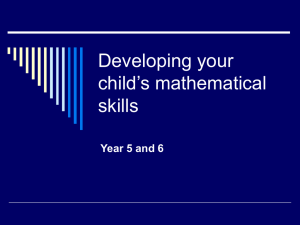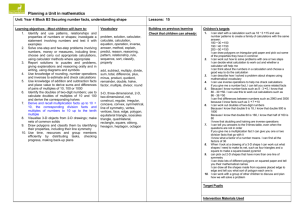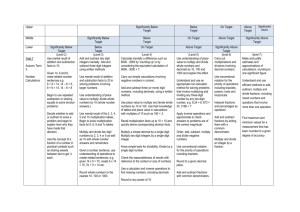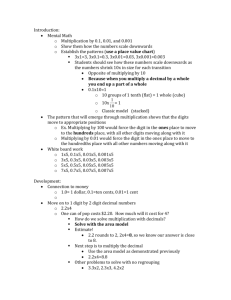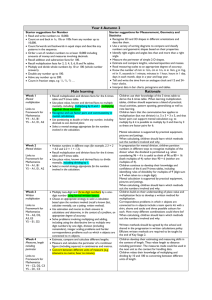Year_5_Block_A_Unit_1 - Buckinghamshire Grid for Learning
advertisement
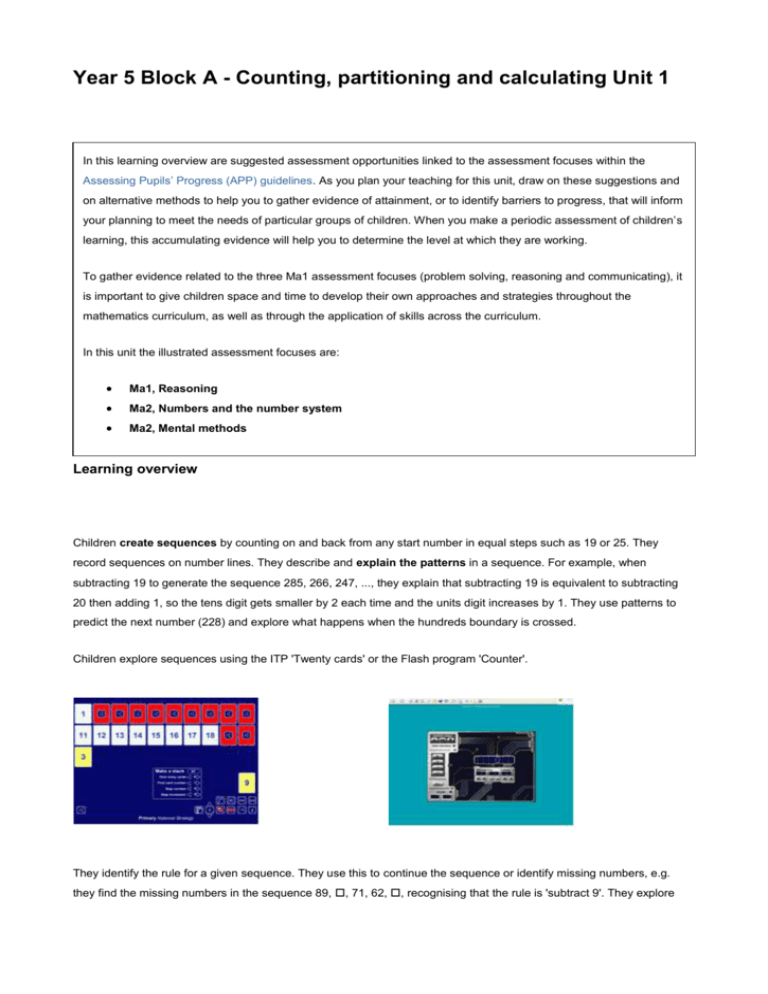
Year 5 Block A - Counting, partitioning and calculating Unit 1 In this learning overview are suggested assessment opportunities linked to the assessment focuses within the Assessing Pupils’ Progress (APP) guidelines. As you plan your teaching for this unit, draw on these suggestions and on alternative methods to help you to gather evidence of attainment, or to identify barriers to progress, that will inform your planning to meet the needs of particular groups of children. When you make a periodic assessment of children’s learning, this accumulating evidence will help you to determine the level at which they are working. To gather evidence related to the three Ma1 assessment focuses (problem solving, reasoning and communicating), it is important to give children space and time to develop their own approaches and strategies throughout the mathematics curriculum, as well as through the application of skills across the curriculum. In this unit the illustrated assessment focuses are: Ma1, Reasoning Ma2, Numbers and the number system Ma2, Mental methods Learning overview Children create sequences by counting on and back from any start number in equal steps such as 19 or 25. They record sequences on number lines. They describe and explain the patterns in a sequence. For example, when subtracting 19 to generate the sequence 285, 266, 247, ..., they explain that subtracting 19 is equivalent to subtracting 20 then adding 1, so the tens digit gets smaller by 2 each time and the units digit increases by 1. They use patterns to predict the next number (228) and explore what happens when the hundreds boundary is crossed. Children explore sequences using the ITP 'Twenty cards' or the Flash program 'Counter'. They identify the rule for a given sequence. They use this to continue the sequence or identify missing numbers, e.g. they find the missing numbers in the sequence 89, , 71, 62, , recognising that the rule is 'subtract 9'. They explore sequences involving negative numbers using a number line. For example, they continue the sequence –35, –31, –27, ... Assessment focus: Ma1, Reasoning Look for evidence of children identifying patterns. For example, as they work with sequences that increase or decrease in steps of a regular size, they might work out that the difference is always 5. Look for children who are beginning to predict whether particular numbers will be in the sequence or not. For example, they might notice that each of the numbers in a sequence is 2 more than a multiple of 5, and use this to reason that 47 will be in the sequence. by recognising that the rule is 'add 4'. Children read and write large whole numbers. For example, they work in pairs using a set of cards containing six- and seven-digit numbers: one child takes a card and reads the number in words; their partner keys the number they hear into a calculator; they check that the calculator display and the number card match. Children recognise the value of each digit and they use this to compare and order numbers, for example, they explain which has the greater value, the 5 in 3215067 or the 5 in 856207. They compare two numbers and explain which is bigger and how they know. They solve problems such as: Use a single subtraction to change 207070 to 205070 on your calculator. Children use calculators (possibly by setting a constant function) or the ITP 'Moving digits' to explore the effect of repeatedly multiplying/dividing numbers by 10. They compare the effect of multiplying a number by 1000 with that of multiplying the number by 10 then 10 then 10 again (and similarly for division). They use digit cards and a place value grid to practise multiplying and dividing whole numbers by 10, 100 or 1000 and answer questions such as: 32 500 ÷ = 325 How many £10 notes would you need to make £12 000? Assessment focus: Ma2, Numbers and the number system Look for evidence of children understanding place value in four-digit numbers, and those who can begin to say what each digit represents in a five- or six-digit number. Look for children who can use their knowledge of place value to explain the effect of multiplying and dividing whole numbers by 10. Identify children who can extend this understanding to multiplying and dividing whole numbers by 100 and 1000. Children rehearse multiplication facts and use these to derive division facts, to find factors of two-digit numbers and to multiply multiples of 10 and 100, e.g. 40 × 50. They use and discuss mental strategies for special cases of harder types of calculations, for example to work out 274 96, 8006 - 2993, 35 × 11, 72 ÷ 3, 50 × 900. They use factors to work out a calculation such as 16 × 6 by thinking of it as 16 × 2 × 3. They record their methods using diagrams (such as number lines) or jottings, and explain their methods to each other. They compare alternative methods for the same calculation and discuss any merits and disadvantages. They record the method they use to solve problems such as: How many 25p fruit bars can I buy with £5? Find three consecutive numbers that total 171. Assessment focus: Ma2, mental methods Look for evidence of the mental calculations that children perform, and the strategies they choose to use. Look for children who can add and subtract two-digit numbers mentally and can apply this to calculations with larger numbers. Look for children who can recall multiplication facts, noting which facts they can remember, and for those who can use their knowledge of multiplication facts and place value to solve calculations involving multiples of 10, e.g. children who use knowledge of 5 × 7 to solve 50 × 7 and 50 × 70. Children consolidate written methods for addition and subtraction. They explain how they work out calculations, showing understanding of the place value that underpins written methods. They continue to move towards more efficient recording, from expanded methods to compact layouts. Addition examples: Carry digits are recorded below the line, using the words 'carry ten' or 'carry one hundred', not 'carry one'. Subtraction, illustrating 'difference', is complementary addition or counting up: The decomposition method, illustrating the 'take away' model of subtraction, begins like this: Children use written methods to solve problems and puzzles such as Choose any four numbers from the grid and add them. Find as many ways as possible of making 1000. Place the digits 0 to 9 to make this calculation correct: - = Two numbers have a total of 1000 and a difference of 246. What are the two numbers? Objectives End-of-year expectations (key objectives) are emphasised and highlighted Children's learning outcomes are emphasised Assessment for learning Explain reasoning using diagrams, graphs and text; refine ways of recording using images and symbols Tell me how you solved this problem. What does this calculation/diagram tell you? If I doubled this number, what would you have to change? I can write down how I solved a problem, showing every step Count from any given number in whole-number and decimal steps, extending beyond zero when counting backwards; relate the numbers to their position on a number line I can find missing numbers in a sequence that includes negative numbers Explain what each digit represents in whole numbers and decimals with up to two places, and partition, round and order these numbers I can say what any digit represents in a number with up to seven digits Use knowledge of place value and addition and subtraction of two-digit numbers to derive sums and differences and doubles and halves of decimals (e.g. 6.5 ± 2.7, half of 5.6, double 0.34) I can work out sums and differences of decimals with two Create a sequence that includes the number –5. Describe your sequence to the class. Here is part of a sequence:, –9, –5, –1,. Explain how to find the missing numbers. Explain how you would find the missing numbers in this sequence: 10, , 4, 1, , –5, What is the 'rule' for the sequence? What is the value of the 7 in 3 274 105? Write in figures forty thousand and twenty. A number is partitioned like this: 4 000 000 + 200 000 + 60 000 + 300 + 50 + 8 Write the number. Now read it to me. What is 4773 rounded to the nearest hundred? A car costs more than £8600 but less than £9100. Tick the prices that the car could cost. £8569 £9090 £9130 £8999 Look at these calculations with two-digit decimals. Tell me how you could work them out in your head. digits Use efficient written methods to add and subtract whole numbers and decimals with up to two places I can explain each step when I write addition and subtraction calculations in columns Recall quickly multiplication facts up to 10 × 10 and use them to multiply pairs of multiples of 10 and 100; derive quickly corresponding division facts I know my tables to 10. I can use them to work out division facts and to multiply multiples of 10 and 100 Identify pairs of factors of two-digit whole numbers and find common multiples (e.g. for 6 and 9) [Point to a 'carry digit' 1.] What is the value of this 1? Why is it there? I add two numbers. One has a 3 in the thousands column, the other has a 5. The answer has 9 in the thousands column. How is this possible? Work out 3275 - 1837, explaining every step that you write. If someone had forgotten the 8 times-table, what tips would you give them to help them to work it out? What links between multiplication tables are useful? How many nines are there in 63? Divide 80 by 4. Write in the missing numbers. 5 × 70 = 600 × 4 = 4 × = 200 What is 50 times 90? Here are four number cards. I can find a pair of factors for a two-digit number Which two number cards are factors of 42? Put a ring around the numbers which are factors of 30. 4 5 6 20 60 90 How can you use factors to multiply 15 by 12? Use understanding of place value to multiply and divide whole numbers and decimals by 10, 100 or 1000 I can multiply or divide a whole number by 10, 100 or 1000 Extend mental methods for whole-number calculations, for example to multiply a two-digit by a one-digit number (e.g. 12 × 9), to multiply by 25 (e.g. 16 × 25), to subtract one near-multiple of 1000 from another (e.g. 6070 - 4097) I can work out some calculations in my head or with jottings. I can explain how I found the answer This calculator display shows 0.1. Tell me what will happen when I multiply by 100. What will the display show? What number is ten times as big as 0.01? How do you know that it is ten times 0.01? I divide a number by 10, and then again by 10. The answer is 0.3. What number did I start with? How do you know? How would you explain to someone how to multiply a decimal by 10? What is a quick way to multiply by 1000? To divide by 100? How many hundreds are there in one thousand? Divide 9300 by 100. Which of these subtractions can you do without writing anything down? Why is it possible to solve this one mentally? What clues did you look for? What is the answer to the one that can be solved mentally? How did you find the difference? Talk me through your method. [If the child explains a method of counting backwards, ask:] Is it possible to count up as well? Why will this give the same result? Which is easier? If 2003 is the answer to a similar question, what could the question be? Use knowledge of rounding, place value, number facts and inverse operations to estimate and check calculations Roughly, what will the answer to this calculation be? How do you know that this calculation is probably right? Could you check it a different way? I can estimate and check the result of a calculation Present a spoken argument, sequencing points logically, defending views with evidence and making use of persuasive language I can describe each stage of my calculation method (e.g. for 18 × 25). I can explain why it is a good method for this calculation These cards describe the steps in adding £4.65, 98p and £3.07. Arrange the cards in order. Write a list of the steps you would take to solve this problem: A pack of plums costs 68p. Mark bought three packs of plums. How much change did he get from a £5 note? Explain to the class why you solved the problem in that way.
